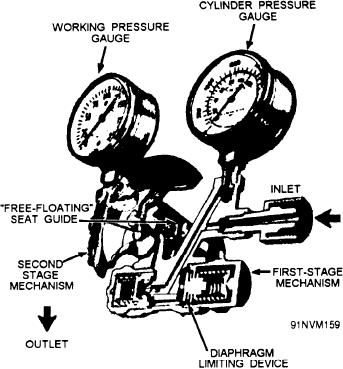
which the high-pressure gases pass, a valve seat to
close off the nozzle, a diaphragm, and balancing
springs. These are all enclosed in a suitable housing.
Pressure gauges are provided to indicate the pressure
in the cylinder or pipeline (inlet), as well as the
working pressure (outlet). The inlet pressure gauge,
used to record cylinder pressures, is a high-pressure
gauge; the outlet pressure gauge, used to record
working pressures, is a low-pressure gauge. Acetylene
regulators and oxygen regulators are of the same
general type, although those designed for acetylene are
not made to withstand such high pressures as are those
designed for use with oxygen cylinders.
In the regulator, the gas enters the regulator
through the high-pressure inlet connection and passes
through a glass wool filter that removes dust and dirt.
Turning the adjusting screw in, to the right, allows the
gas to pass from the high-pressure chamber to the
low-pressure chamber of the regulator, through the
regulator outlet, and through the hose to the torch.
Figure 8-5.--Two-stage regulator.
Turning the adjusting screw to the right INCREASES
the working pressure; turning it to the left
DECREASES the working pressure. The high-
a handle (body), two tubes (one for oxygen and one for
pressure gauge is graduated in pounds per square inch
acetylene), a mixing head, and a tip. Welding tips are
from 0 to 3,000 for oxygen and 0 to 400 for acetylene.
made from a special copper alloy, which dissipates
This permits reading of the gauge to determine
heat (less than 60 percent copper), and are available in
cylinder pressure. The gauges are graduated to read
correctly at 70F. The working pressure gauge is
different sizes to handle a wide range of plate
graduated in pounds per square inch from 0 to 30 for
thicknesses.
acetylene and from 0 to 50, 0 to 100, 0 to 200, or 0 to
There are two types of welding torches, the
400 for oxygen, depending upon the purpose for which
low-pressure type and the medium-pressure type. In
the regulator is designed. For example, on regulators
the low-pressure type, the acetylene pressure is 1 psi
designed for heavy cutting, the working pressure
or less. A jet of high-pressure oxygen is necessary to
gauge is graduated in pounds per square inch from 0
produce a suction effect, which draws in the required
to 400.
amount of acetylene. This is accomplished by the
The two-stage regulator is similar in principle to
design of the mixer in the torch, which operates on the
the one-stage regulator, the chief difference being that
injector principle. The welding tips may or may not
the total pressure drop takes place in two steps instead
have separate injectors designed into the tip. A typical
of one. In the high-pressure stage, the cylinder
mixing head for the low-pressure or injector type of
pressure is reduced to an intermediate pressure. In the
torch is shown in figure 8-6.
low-pressure stage, the pressure is reduced from the
intermediate pressure to a working pressure. A
In the medium-pressure torches, the acetylene is
two-stage regulator is shown in figure 8-5.
burned at pressures from 1 to 15 psi. These torches are
made to operate at equal pressures for acetylene and
WELDING TORCHES
oxygen. They are sometimes called equal-pressure or
balanced-pressure torches. The medium-pressure
The oxyacetylene welding torch is used to mix
torch is easier to adjust than the low-pressure torch
oxygen and acetylene gas in the proper proportions
and, because equal pressures are used, you are less
and to control the volume of these gases burned at the
likely to get a flashback. This means that the flame is
welding tip. Torches have two needle valves, one for
less likely to catch in or back of the mixing chamber.
adjusting the flow of oxygen and the other for
A typical equal-pressure torch is shown in figure 8-7.
adjusting the flow of acetylene. In addition, they have
8-4

